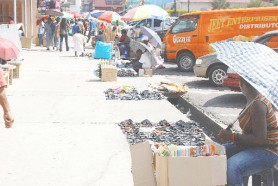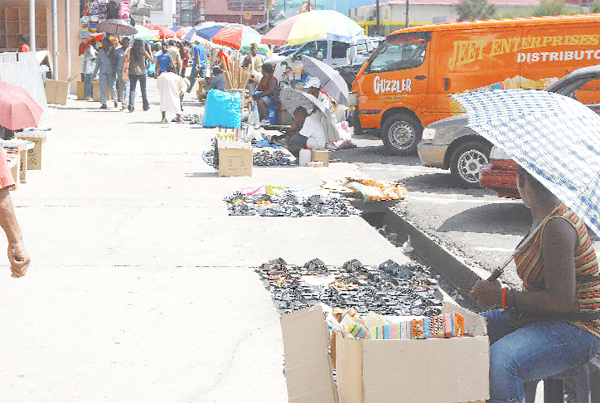…but final touches being held up by City Council cash woes
More than four months after the May scheduled opening of the new Water Street Vendors Arcade neither the Georgetown City Council nor the occupants of the ‘new look’ facility can say with any degree of certainty when the formal ribbon-cutting ceremony will take place. As some stallholders still work feverishly to complete their enclosures, a new opening date set for later this month also seems in imminent danger of being postponed. Those stallholders who have either invested their savings in the venture or incurred loans in the process cannot afford to concern themselves with the ritual of a formal opening. They have already begun trading.

The completion of the project which, even in its present incomplete state, has already done much to transform the ambience of one of the busiest trading areas in the city, is enmeshed in the kinds of difficulties that are painfully familiar to the Georgetown City Council. If the near completion of the Arcade means that the controversies that have dogged the occupancy of this prime piece of urban real estate are now a thing of the past, issues associated with the Council’s financial crisis and a crew of moody municipal construction workers bristling over the irritant of habitual late salary payments and understandably indifferent to considerations of deadline threaten to put a brake on the final completion of the project for at least the next month.
The various City Hall officials to whom Stabroek Business spoke earlier this week are irritatingly measured in their comments on the state of play at the Arcade, mindful, they say, of an edict that the prerogative of engaging the press is limited only to certain senior municipality functionaries. We found too that the Town Clerk, one of the functionaries authorised to speak could not be reached by telephone earlier this week.
Gregory Erskine, The City Engineer whose frustration over the hiccups that have dogged the project is reflected in the irritation in his tone agreed to talk about the project. He concedes that “money is part of the problem.” Several things remain to be done. There are half a dozen or so bridges to be built across the drain separating the pavement from the road on Water Street; there is the fence bordering the Arcade on its western side that needs to be re-erected, having been broken down to allow for access for materials brought to the work site and there is the construction of the large eating area as part of the Arcade which, again, is Council’s responsibility. The completion of the Food Court area is hostage to the problems which the Council faces with its disgruntled workers. Erskine has had to manage a crew of construction workers whom, the stallholders at the Arcade say, are moody and temperamental, their disposition shaped, it seems, by the fact of their irregular pay dates. When Stabroek Business visited the Arcade earlier this week we were told that the municipality construction workers had only just concluded an unofficial ‘go slow’ that had put a further brake on the construction of the Food Court.
Other bureaucratic issues – just the kinds of issues that continue to slow small business

growth – like the timing of the installation of telephone, electricity and water facilities and, incredibly, the management of the toilet facilities, remain to be resolved. The Guyana Power and Light, one of the stallholders told Stabroek Business, has taken the position that until the stalls are completed the Arcade will remain without electricity despite the fact that some of its occupants have already paid for the service. As far as the toilet facilities are concerned the municipality is considering its privatization – that is, its management and maintenance will be outsourced and users will have to pay for use of the facility.
Even in its incomplete state, however, the transformation that has taken place at the Arcade has been dramatic. Once a foreboding, vermin-infested commercial shantytown where even the slightest hint of rain brought pools of stagnant and heavily polluted water that bred swarms of mosquitoes, and where the dimly lit interior meant that few patrons ventured inside the facility, the Arcade now has a decidedly more welcoming ambience. New stands, a pristine red metal fence and billboards advertising a range of goods and services from cellular phones to soap powder lend the Water Street entrance to the Arcade a more businesslike aura and a more welcoming façade. The stallholders themselves appear more satisfied, more energetic and the clutter of goods that traditionally encumbered the walkway outside the arcade has lessened considerably.
For all the delays in its completion The Water Street Vendors Arcade is still a triumph for small and micro business. Some of the stallholders speak animatedly about their process of transformation from street vendors to store owners.
Many of these are intriguing stories of dogged persistence, mind-boggling determination and precarious business risks against which the likelihood of meaningful returns has not, in many cases, been carefully measured.
For the time being at least the ‘new’ Arcade is yet to put its past behind it. The disappearance of the decrepit ambience has not coincided with a radical transformation in the level of customer support for the Arcade. If a greater number of shoppers now venture into the facility, the throngs which the stallholders are hoping will make their investments worthwhile are yet to materialise. Worryingly, some of the stallholders situated furthest from the Arcade’s Water Street entrance still persist in the old habit of using their stalls as storage bonds and moving limited quantities of stock to the pavement. Since the whole idea behind the erection of the Arcade is to help reduce the level of pavement vending, what may well be needed is a concerted public image-building programme which one stallholder suggested to Stabroek Business should commence with the ‘Grand Opening,’ whenever that occurs. That, hopefully, would boost the popularity of the Arcade and remove the need for stallholders to return to part-time pavement vending.
The project to create the Arcade has thrown together the more than 200 enterprising vendors and their families and a municipality that can some times be an unreliable ally. At the start the construction of the cubicles out of which the owners ply their trade, the building of the individual enclosures was the responsibility of the owners themselves. The infrastructure, walkways, toilets, bridges, fences et al were the responsibility of the Council. The stallholders have responded as best they can, building the stalls to the specifications determined by the Council, an exercise that cost, in some cases, in excess of half a million dollars. Apart from the costs of materials and workmanship the stallholders have decided to install huge metal doors that roll upward to open then downward to close. Security is one of their main concerns.
Those stalls that border the passageways that cut through the length of the Arcade are vulnerable to the elements. Stallholders, therefore, must erect sheds – again to specifications dictated by the Council – to keep the elements out. That means additional cost.
Understandably, some stallholders have been unable to stay the course and there is evidence of incomplete stalls that have been boarded up, at least temporarily, their owners unable afford the completion costs. As is customarily the case with small and micro businesses, adequate financing is hard to come by. Whether and when those who have temporarily shelved their ventures will resume work is uncertain. Meanwhile, the owners of the unfinished stalls remain ever vulnerable to the threat that unfinished, unoccupied property will be repossessed by the Council.
It could be months before all is well with the Vendors Arcade and when issues of infrastructure are settled those of marketing the facility, persuading shoppers that it is worth a peep remain. Those stallholders who have resisted the temptation to use the pavement have initiated their own marketing campaigns, calling out to passers-by, seeking to entice them into the facility.

